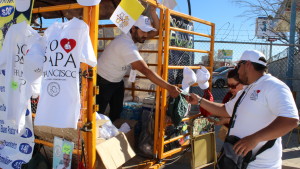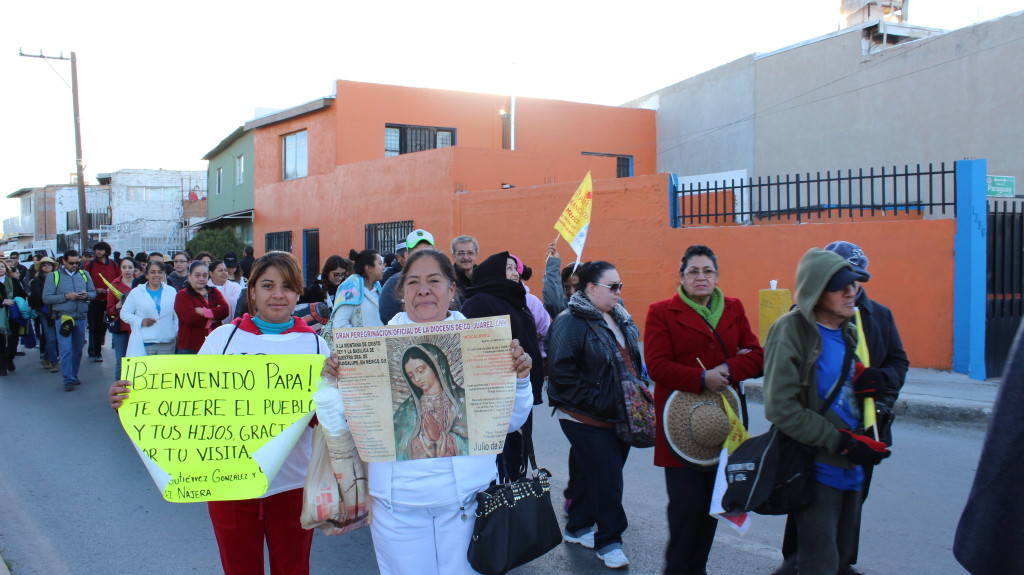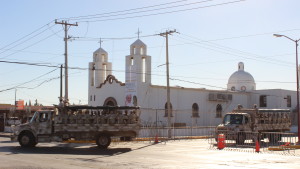Pope Francis Threads Peace in Juárez, Mexico
Over 200,000 pilgrims awaited Pope Francis’ arrival in Ciudad Juárez, Mexico, on February 17, anxious for a blessing and a moment of peace. The Pope chose the beleaguered border town to conclude his week-long tour of Mexico, where he addressed issues including forced migration, mass incarceration, and drug violence. “I was often at the point of tears,” Pope Francis exclaimed at a mass celebrated on February 17 in Ciudad Juárez, Mexico, “seeing a people that suffered so much, with so much hope.”

But for the citizens of Ciudad Juárez, the visit was more than an ecclesiastic visit or a political message. It was an opportunity to show the world that their city, once infamously known as the murder capital of the world, is on the road to peace. “Fortunately, this time we will capture the world’s attention but in a positive light, because of the Pope’s visit and not because of the violence we suffered for years,” commented Daniel Alberto Figueroa, a souvenir salesman. “We are doing well, we are pushing ahead, but I also believe his visit is going to help us–is going to fill us with peace and tranquility,” he added.
Along the road, billboards echoed Figueroa’s perspective with messages such as, “Juárez welcomes you with love and peace, Francis.” Meanwhile, pilgrims wore “Juárez in Peace” shirts and the diocese organized a papal mass, as well as visits to the city’s inmates and entrepreneurs.
Even the city’s landscape changed in anticipation of the messenger from the Holy See.
In the weeks before the visit, the city’s administration rushed to fix potholes, broken telephone cables, and the greenery the Pope would see as he drove through the city. Famously, Reforma ran an article titled, “Pope Works Miracles Prior to Arrival in Mexico” covering the uncharacteristic investment in the urban landscape in anticipation of the dignitary’s visit.
In addition to the physical changes, the city witnessed a large influx of federal and state security forces. On social media, El Diario de Juárez police beat journalist Lucy Sosa remarked that such security was reminiscent of former President Calderon’s military intervention in the city. Unlike last time, though, citizens now approached the forces without fear, comfortably asking the verdes for directions as they paraded the streets.
Of course, the visit also drew significant scrutiny, and the Pope’s agenda was criticized for not including the families of the hundreds of disappeared women believed to be kidnapped and killed in acts of femicide. Sosa reported that, in protest, the families painted pink crosses on poles in the Pope’s path. Authorities quickly removed the paintings.
Nonetheless, when the Pope finally arrived in the city, a quarter of the city stood in praise, either along his path or in wait of the papal mass, to await the pontiff’s blessing.

The Pope’s visit was a historic event for Ciudad Juárez. Presidents, artists, and sports teams may fill a stadium or an auditorium, but the Pope was able to gather nearly a quarter of the city together in his wait.
As I stood beside pilgrims from Oklahoma, Los Angeles, Chihuahua City, and Urique – many of whom were natives of Ciudad Juárez – I realized the Pope was already uniting our broken city.
For some, the city was their birthplace. For others, a temporary workplace. For many, it was the city across the border; the city where the Pope would be; or just a good opportunity to make a living by selling Vatican flags, caps, and shirts.
Yet, for all, it was also the city of Violence. Survival. Nostalgia.
I was only a teenager when the violence erupted in Ciudad Juárez. Even after I left Juárez, the city never seemed to leave me – the questions, memories, traumas, and emotional scars remained.
Yet, my most tragic memory was losing my neighbors. At some point after the violence stopped, our social culture changed entirely. We stopped greeting strangers in the street. We stopped opening our windows while driving, and began locking our doors at all times. We even stopped buying snacks from the informal merchants while driving, for fear that they were “involved.”

The police would exploit some businesses, the cartel others. The army came in with their rifles; nobody trusted them. Everyone was suspicious.
Our social fabric was torn.
This was not lost on the Pope, who dedicated his papal mass to the victims of violence and migration. He laid flowers next to the shoes of a fallen migrant, and cited Mexican poet Octavio Paz when he referenced the city’s troubled past. He listened to the testimony of our prisoners, and then reminded us that their crimes are a by-product of our own disregard for human life. He applauded the resilience of the city’s entrepreneurs, but reminded them of their moral duty to provide for, not exploit, their fellow brothers.
When the Pope came to our city, he brought the ill, the wealthy, the perpetrators, the bystanders, and the exploited to pray, together, for a restored and dignified society.
“The night may seem long and very dark,” Pope Francis added during his closing speech, “but in these days I was able to confirm that within this people, many lights exist and announce our hope.” His words echoed all of us pilgrims’ hope: that with threads of peace shining light on the horizon, Ciudad Juárez may finally turn the page and begin a new chapter in its history.
